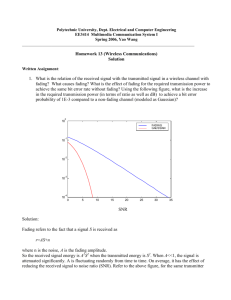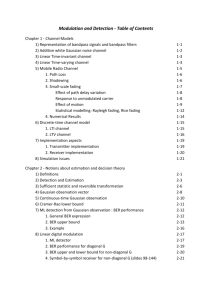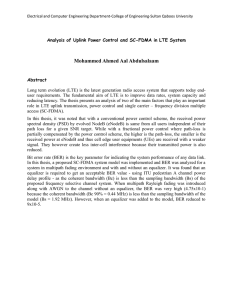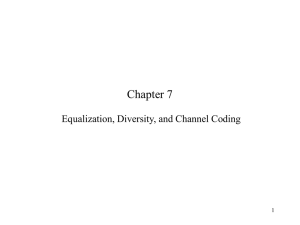Performance Analysis of Different Channel Models In
advertisement
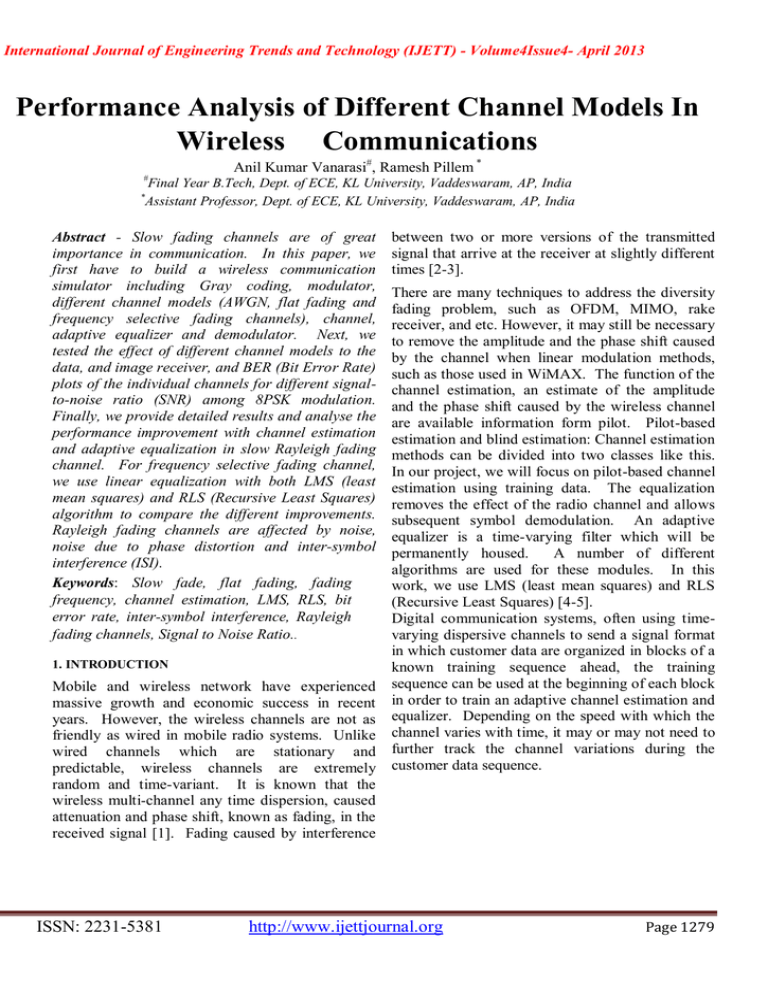
International Journal of Engineering Trends and Technology (IJETT) - Volume4Issue4- April 2013 Performance Analysis of Different Channel Models In Wireless Communications Anil Kumar Vanarasi#, Ramesh Pillem * # * Final Year B.Tech, Dept. of ECE, KL University, Vaddeswaram, AP, India Assistant Professor, Dept. of ECE, KL University, Vaddeswaram, AP, India Abstract - Slow fading channels are of great importance in communication. In this paper, we first have to build a wireless communication simulator including Gray coding, modulator, different channel models (AWGN, flat fading and frequency selective fading channels), channel, adaptive equalizer and demodulator. Next, we tested the effect of different channel models to the data, and image receiver, and BER (Bit Error Rate) plots of the individual channels for different signalto-noise ratio (SNR) among 8PSK modulation. Finally, we provide detailed results and analyse the performance improvement with channel estimation and adaptive equalization in slow Rayleigh fading channel. For frequency selective fading channel, we use linear equalization with both LMS (least mean squares) and RLS (Recursive Least Squares) algorithm to compare the different improvements. Rayleigh fading channels are affected by noise, noise due to phase distortion and inter-symbol interference (ISI). Keywords: Slow fade, flat fading, fading frequency, channel estimation, LMS, RLS, bit error rate, inter-symbol interference, Rayleigh fading channels, Signal to Noise Ratio.. between two or more versions of the transmitted signal that arrive at the receiver at slightly different times [2-3]. There are many techniques to address the diversity fading problem, such as OFDM, MIMO, rake receiver, and etc. However, it may still be necessary to remove the amplitude and the phase shift caused by the channel when linear modulation methods, such as those used in WiMAX. The function of the channel estimation, an estimate of the amplitude and the phase shift caused by the wireless channel are available information form pilot. Pilot-based estimation and blind estimation: Channel estimation methods can be divided into two classes like this. In our project, we will focus on pilot-based channel estimation using training data. The equalization removes the effect of the radio channel and allows subsequent symbol demodulation. An adaptive equalizer is a time-varying filter which will be permanently housed. A number of different algorithms are used for these modules. In this work, we use LMS (least mean squares) and RLS (Recursive Least Squares) [4-5]. Digital communication systems, often using timevarying dispersive channels to send a signal format in which customer data are organized in blocks of a 1. INTRODUCTION known training sequence ahead, the training Mobile and wireless network have experienced sequence can be used at the beginning of each block massive growth and economic success in recent in order to train an adaptive channel estimation and years. However, the wireless channels are not as equalizer. Depending on the speed with which the friendly as wired in mobile radio systems. Unlike channel varies with time, it may or may not need to wired channels which are stationary and further track the channel variations during the predictable, wireless channels are extremely customer data sequence. random and time-variant. It is known that the wireless multi-channel any time dispersion, caused attenuation and phase shift, known as fading, in the received signal [1]. Fading caused by interference ISSN: 2231-5381 http://www.ijettjournal.org Page 1279 International Journal of Engineering Trends and Technology (IJETT) - Volume4Issue4- April 2013 1. Convergence rate: This is defined as the number of iterations of the algorithm is necessary in response to steady state inputs that converge close enough to the optimal solution. A fast convergence rate allows the algorithm to quickly respond to a stationary unknown environment statistics. Moreover, it allows the algorithm to statistical fluctuations on when. In a non-stationary environment. Figure 1 show the flowchart Mat our laboratory simulation that is used in this work. 2. SYSTEM MODEL 2.1 Channel Modelling The flat fading channel and frequency selective fading channel uses parameters like transmitted symbol period Ts, coherence time Tc and RMS delay spread . For slow fading channel Ts << Tc and for flat fading channel Ts >> , which implies that for slow flat fading channel << Ts << Tc. For frequency selective fading channel Ts < , which implies that for slow frequency selective fading channel Ts < < Tc. Clarke and Gans fading model is used for modeling the fading channels with Rayleigh distribution. A sequence of data (pilot data) already known to the receiver is transmitted through the channels and the error in the channels is estimated by calculating BER of the received data for various SNR [6-8]. This method of estimation is called pilot estimation. The estimated error in the received data is eliminated by process of channel equalization. 2.2-Channel equalizer The performance of a calculation algorithm is determined by several factors including: ISSN: 2231-5381 2. Incorrect setting: an algorithm of interest for these parameters provide a quantitative measure of the amount by averaging the final value deviates the mean square error within a group of adaptive filters from the optimum minimum mean square error. 3. Computational Complexity: This is the number of operations required to make a complete iteration of the algorithm. 4. Numerical properties: If an algorithm can be implemented numerically inaccuracies due to rounding produces a noise and display errors in the computer. These kinds of errors affect the stability of the algorithm. The radio channel and use of the subscriber equipment is another key issue. The speed of the mobile unit determines the channel fading rate and the Doppler spread, which is directly related to the coherence of the channel. Algorithms for adaptive equalizer can be addressed in decisions adjust mode indicated by the use of a detector or property equalizer in training mode with just only pilot data to train the detector. In the decision directed mode, Equalizer uses a captured version of its output signal when adjusting the weights [9-10]. Start adaptive equalizer usually with training and change in decisions directed mode after all symbols in the training sequence. Not the syntax of a training sequence or the equalizer has exhausted all symbols in the training sequence and still has more input to process symbols: The function works in decision-directed phase compensation mode when http://www.ijettjournal.org Page 1280 International Journal of Engineering Trends and Technology (IJETT) - Volume4Issue4- April 2013 one of these conditions is met. We can choose to reset the estimated weights of an equalizer or not before starting a new training cycle equalizer at the next time coherence. Before reset when set filtering property to 1, while each coherence equalizer is the equalizer of the state are the results of the previous training of the coherence time. If 0, use the equalization of the result of the last coherence time of training mode either directed or decision mode [11-12]. 3. SIMULATION RESULTS : AND In Fig. 3, the received image plot at SNR = 5 dB, we see that there is some random noise in the image. From simulation results, the received image quality is almost the same as in a SNR = 10dB. 3. BER of Image vs. random data The correlation between image pixels does not affect the BER in AWGN channel. EXPERIMENTAL We discuss our simulation results through two steps. First, we analyse the performance comparison of different parameters in each channel. Then we analyse the performance by comparing three different channels under the same parameter setting. All simulations are based on 8PSK modulation with Gray code. 3.1 For AWGN Channel 1. BER of simulation vs. theoretical As shown in FIG. 2 shows the BER performance simulation results are exactly the same theoretical BER. Fig. 2: BER of Simulation vs. Theoretical 2. Image quality of received vs. original ISSN: 2231-5381 Fig3.(a) (b) Figure 3. (a) Original (b) The image quality of the received coherence time. If set to back up before the filtering property to 1, while each coherence equalizer sets the state of the equalizer of the training results of the last coherence time coming. If 0, use the equalization of the result of the last coherence time of training mode either directed or decision mode http://www.ijettjournal.org Page 1281 International Journal of Engineering Trends and Technology (IJETT) - Volume4Issue4- April 2013 3.2 For Flat Fading Channel 1. BER of simulation vs. theoretical Fig 5(a) Fig.4:BER of Simulation vs. Theoretical As shown in FIG. 4 shows the BER performance simulation result worse than theoretical BER. This makes sense, since the theoretical BER, based on the assumption that we know exactly the phase information of the modulated signal. Due to the time-variant channel estimation error, we always phase information. We (b) also find the BER performance is dramatically Fig. 5: (a) Without Adjustment (b) with Adjustment improved in low SNR, although not in high SNR. 3. BER of Image vs. random data This is also useful because at low SNR white Gaussian noise dominates the BER errors The correlation between image pixels does not affect the BER in flat fading channel. promoting SNR can be improved while at high SNR estimation phase errors dominate the BER 3.3 For Frequency Selective Fading Channel error that cannot be improved simply by increasing 1. BER of simulation vs. theoretical SNR. As shown in FIG. 6 show the BER performance simulation result worse than theoretical BER. The 2. Image quality of received vs. adjusted reason is the same for the above mentioned reason In Fig. 5, the received image plot at SNR = 10 dB, in flat fading channel directed. Unlike flat fading we see that except for some random noise, there is channels, the BER performance drastically low some block noise in the picture. m. This is due to SNR is improved while high SNR even the coherence time of a phase difference estimation degradation. This is also useful because in high error. SNR, phase estimation error and ISI dominate the BER error and the estimation error is even severe ISI, cause even worse the BER cause 2. LMS vs. RLS: ISSN: 2231-5381 http://www.ijettjournal.org Page 1282 International Journal of Engineering Trends and Technology (IJETT) - Volume4Issue4- April 2013 The BER performances are nearly the same for both. But during the simulation, we find LMS need more training data to converge on the equalizer compared to RLS, while the latter is more complex and time consuming. 3. Image quality of received vs. original Figure 7 shows the received image plot is the SNR = 15dB, we see that other than a random noise and block noise in the picture, there is some overlap in the image. This is caused by frequency-selective fading channel due to the white Gaussian noise phase estimation error in a coherence time and ISI. (b) Fig. 6: BER of Simulation vs Theoretical (c) (d) Fig. 7(a) ISSN: 2231-5381 Fig. 7 (a): Without Equalization (LMS) (b) With Equalization (LMS) (c) Without Equalization (RLS) (d) With Equalization (RLS) http://www.ijettjournal.org Page 1283 International Journal of Engineering Trends and Technology (IJETT) - Volume4Issue4- April 2013 4. BER of Image vs. random data The correlation between pixels does not affect the BER in selective fading channel, since PN code we use to train the equalizer. 4. CONCLUSIONS From Figs. 3, 5 and 7, one can see that in AWGN channel, the image degraded by noise. In flat fading channel, the image degraded by random and block noise. In frequency-selective fading channel, the image is affected by noise, block noise and overlap. From Figs. 2, 4 and 6 we see the BER performance is best in AWGN channel, worse in flat fading channel and the worst in selective fading channel. They are just like the theoretical analysis. In this paper, we test the effect of three different channel models, AWGN channel, flat fading channel and frequency selective fading channel, and the image data under two scenarios. We also compare and analysis to improve the channel estimation and adaptive equalization in slow fading channel. REFERENCES [2] M.M. Salah, A.A. Elrahman, “Coded OFDM Scheme for Image Transmission Over Time-varying Multipath Rayleigh Fading Channel”, in IEEE Mediterranean Electro technical Conf.Wireless Commun., pp. 602-607, April 2010. [3] J.Bhalani, A.I. Trivedi, Y.P. Kosta, “Performance Comparison of Nonlinear and Adaptive Equalization Algorithms for Wireless Digital communication. in First Asian Himalayas Int. Conf.Wireless Commun., pp. 1-5, Nov. 2009. [4] Monsen P., “Adaptive Equalization of the SlowFading Channel”, IEEE Trans., IT-22, pp. 10641075, Aug. 1974. [5] Muhammad Islam, M.A. Hannan, S.A. Samad, A. Hussain,“Performance of RFID with AWGN and Rayleigh FadingChannels for SDR Application”, Lecture Notes in Engineeringand Computer Science, Vol. 2183, pp. 754-758, June 2010. [6] S. Haykin, “Adaptive Filter Theory”, Fourth Edition, 2002. [7] A.V. Oppenheim, R.W. Schafer, J.R. Buck, “Discrete-time [1] T.S. Rappaport, “Mobile Radio Propagation: Small- ISSN: 2231-5381 Scale Fading and Multipath”, in Wireless Communications: Principles andPractice, 2nd ed., Upper Saddle River, N.J., Prentice Hall PTR,2002, pp. 205-223, 2002. . http://www.ijettjournal.org Page 1284
